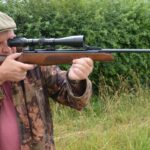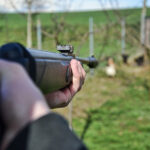Most full-size, bolt-action hunting rifles weigh more or less eight pounds, are around 41 to 42 inches long and have 22- to 24-inch barrels. This means that with scope, sling and everything hunt-ready, the typical rifle rig weighs-in at around nine pounds.
Of course, there are smaller, lighter rifles, as well as bigger, heavier ones for special purposes. For example, recent interest in long-range shooting has spawned an entire genre of rifles that, when ready for shooting, weigh north of 10 pounds – some significantly more.
For the sake of discussion, let’s suppose that the rifle rig will be chambered for a common hunting cartridge ranging from .243 Winchester through any of the .300 magnums. Also, let’s assume that it will wear a variable scope with magnification ranging somewhere in the neighborhood of from 2.5 or 3x to 9 or 10x. That’s where most rifles used for most hunting are found.
And since most hunters are successful, it supposes that such size, weight and sighting works well for most folks in most situations. That’s nice.
But the “average” rig may not be the best for a particular hunt, or even a particular hunter. Those going into the high mountains after wild sheep and goats logically prefer something lighter, while those who plan a 300-yard-plus cross-canyon poke would want something a little heftier with heavier barrel, perhaps more powerful scope and even bipods.
And, of course, there are geezers like me who, the older they get, the more they just like the handiness of a smaller, lighter, livelier rig. The beauty of it is that all of these variations are readily available on the market.
To figure out what might be best for specific situations, there are numbers of things to consider. For example, if the rifle is to be put into and taken out of vehicles a lot during the hunt, shorter barrels are handier. There is a significant difference in this regard between rifles with 22-inch barrels and those with 26-inch tubes. The longer barrels tend to hang-up on things in and around the door.
Another consideration is whether there likely will be shots taken from the standing offhand position, or from any of the other unsupported field positions like sitting or kneeling, rather than from some kind of rest – even impromptu ones like a day pack atop a log.
For standing offhand shots, a neutral balance is nice – that is when the rig is neither barrel-heavy nor barrel-light. If it is too barrel-heavy, it can cause problems going to and remaining on the kill zone and if it is too barrel-light, it can mean the rig jiggles too much when trying to hold steady on a specific aiming point.
Similar challenges exist for the other unsupported field positions, but generally to a little less degree. The point is, that the more naturally the rig settles solidly onto the aiming point, the better the shot will be.
For situations in which precision bullet placement is paramount (like at the longer distances), then a barrel-heavy rig on some kind of rest is the name of the game. This kind of rig can be quite heavy and work superbly. Rests can range from bipods to daypacks atop logs or rocks. The operative concept is that the weight of the rig and the rigidity of the rest work in concert to keep the rig rock-solid for precision shot placement.
More companies now offer some form of super light hunting rifles. These can be great, but there are things to consider when using them. The advantages are that such rigs are generally relatively short and handle like wands. They carry like feathers and are really handy in most ways. But when it comes time for the shot, they can be deceiving. They tend to jiggle around at the moment of the shot, which means that they need to be held deliberately snugly for best results. In fact, the proper grasp/hold for small, light rifles is the same as for big, heavy dangerous game rifles.
Hold them tightly against the shoulder, using the trigger hand/pistol grip hold to control rearward pressure on the trigger and the off-hand to hold the rifle on-target and to exert the rearward pressure against the shoulder. Also, as with dangerous game shooting, stay in the rig THROUGH the shot. Don’t kind of squeeze the trigger and let up on the rearward pressure at the same time. Maintain the solid hold until after recoil.
Deliberately lighter rifle rigs tend to weigh 1½ to 2 pounds less than “normal” hunting rifle. The reason I use the term “rig” is that when discussing hunting rifles, it is necessary to talk about the size and weight of the entire rig, since that is what will be carried into the field or up and down the mountain.
As noted above, typical bolt-action hunting rifle rigs generally weigh-in at around 9 pounds (with scope, sling, etc.). I have a short action Remington 700 Titanium rig in .260 Rem., that, with scope and sling, weighs 7.5 pounds, and a New Ultra Light Arms rig in .308 Win. that weighs an even seven pounds. Or, I have a Model 7 Remington in 7mm-08 that, with its short pencil barrel, scope and sling weighs seven pounds.
All of them are tack-drivers when it comes to first shot accuracy, but here is where it is important to point out characteristics of thin, light barrels. They heat-up quickly. Hence, a five or 10-shot group that is shot quickly will deliver mediocre results. Yet, the first shot from a cold barrel on all of them will go within less than a half-inch of the point of aim. And, when hunting, if the first shot goes precisely where it is supposed to go, there is no need for subsequent shots.
For those relatively few hunters who still use open barrel sights on hunts like I do not infrequently, the right size and weight for a rig that is valid to a couple hundred yards is seven pounds, because that is the weight of two of the finest “handy” rifles ever designed: The Winchester Model 1894 and the Mannlicher-Schoenauer Model 1903.
It is gratifying to stalk to within bow distance with either of those rifles and then dispatch the game animal with a single, well-placed shot. Best of all worlds.
Bottom line: The best size and weight for a hunting rifle is either the one in-hand during the hunt, or the one chosen specifically for that hunt by that particular hunter. Ultimately, it is a personal preference matter.
We hope you enjoyed this article on our no-charge website wonews.com. Of course, this site contains only a small fraction of the stories that Western Outdoor Publications produces each week in its two northern and southern editions and its special supplements. You can subscribe to the print issue that is mailed weekly and includes the easy flip-page full-color digital issues, or you can purchase a digital only subscription. Click here to see the choice.















































